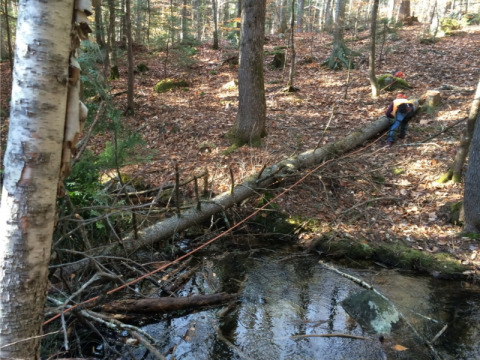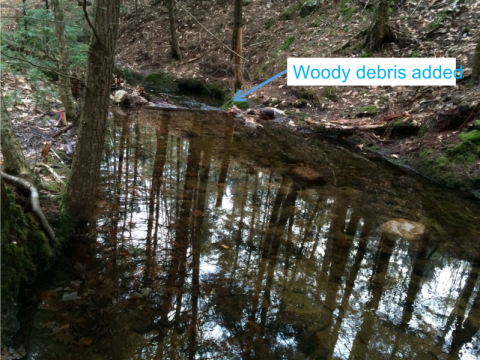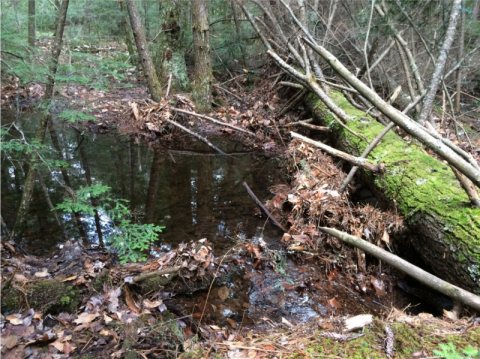Bringing Back Brookies: Improving Stream Habitat for Brook Trout
As a child, I followed my Mom and Dad into the woods on all sorts of different adventures. I often participated in hobbies that my Dad enjoyed as a way to connect and spend time with him. My Dad taught me about photography, hiking, skiing and canoeing. As he got older, fly-fishing became nearly an obsession for him, and so, as a dutiful daughter, a fly fisherman I became.
I enjoyed hiking along the tiny backcountry streams with my Dad and my husband, hoping to outwit a rather wily brook trout who (I hoped) was less familiar with the trickery of artificial flies landing on the surface of the water than the fish in the larger streams nearer the road. I caught as many trees as fish, but I did enjoy observing the river and the life that it nurtured.
One day, I remember sitting down to untangle my fly line from yet another branch, and getting to witness a mayfly nymph crawl out of the river and onto a sunny rock. As it dried, I watched it emerge from its casing, spread out its wings, and fly off. To me, this was a magical experience which took away some of the frustration I was experiencing fishing. It’s been years since I carried a fishing rod into the backcountry; today I prefer to just watch the water, hoping to catch a glimpse of the creatures there living out their lives. I call it Zen fishing.

Getting ready to pull material into place for woody stream additions.
Brook trout depend on clean, cold-water habitats. They generally prefer cool rivers and streams with a mixture of pools, riffles and runs that include undercut banks and fallen trees. They are considered a NH Wildlife Action Plan Species of Greatest Conservation Need as human activities over time have reduced the quality of their habitat. Activities such as clearing land, development, road construction, and road use all have the potential to increase sedimentation and nutrient-loading as well as to reduce the shading of streams, contributing to poorer quality habitat.
Poorly installed culverts can act as barriers to fish movement which can isolate populations and reduce their genetic diversity as well as preventing fish from moving to cooler waters when summer temperatures increase. As a result, fishermen, communities, landowners and other conservation-minded people have worked to remove dams, replace culverts with bridges and to encourage more fish-friendly passages.
As a forester, I am particularly interested in how our actions and management impact the wildlife that live in our forests. State laws for timber harvesting require that some trees remain along streams to provide shade as well as to hold the soil and reduce the potential for erosion and sedimentation in streams from timber harvesting activities. I learned throughout forestry school, that you should never put slash (logging debris – tree tops and branches) into a stream. In fact – it is against the law. So I was intrigued when I heard about people adding woody debris into streams to enhance the habitat.
According to the NH Wildlife Action Plan, “Historic logging practices have resulted in channelized streams surrounded by relatively young forests. Streams surrounded by old growth forests contain large quantities of fallen wood. Much of this wood becomes lodged in the stream channel where it alters streamflow in a manner that traps sediment and scours deeper pools. These deep pools and gravel spawning substrate make ideal brook trout habitat.”

Woody debris addition in Tamworth. Note the large pool it has created.
This past fall, I attended a workshop to learn about how this practice of adding woody debris to streams was being implemented. Dick Fortin has worked with a number of private landowners to help them enhance brook trout habitat on their properties. The NH Natural Resources Conservation Service (NRCS) also provides technical and financial assistance to private landowners to implement these practices as part of comprehensive management plans.
Why add this material? It provides cover for trout, traps sediments and organic matter which increase insect and invertebrate populations, and creates pools that can provide crucial habitat for trout in both the summer and winter months. I can also personally attest that it provides an excellent defense against novice fly fishermen.
Woody debris in streams slows down the water during high-flow events. Without this material to slow down the streams, sediments and organic materials can be carried downstream. The loss of these materials translates into a reduction in biomass of insects, invertebrates and fish. A study conducted on trout streams in Vermont found that, “… where water temperatures were suitably cool, total wood density was an important factor in accounting for Brook Trout biomass, with a strong positive relationship between wood density and the biomass of Brook Trout.” (Kratzer and Warren, 2013)
Dick Fortin begins each project with a habitat survey, documenting the physical characteristics of stream and riparian areas. Then he collects data about the amount of large, woody material (described as wood pieces over 3 feet long and greater than 4 inches in diameter) in the stream. Research from the Green Mountain National Forest suggests that 200 pieces of woody debris per mile is considered a healthy amount. (This translates into about 6% of the stream covered in wood).

Woody debris added. Note the accumulation of leaves and other organic matter behind the log. This will provide food for a variety of insect and invertebrate species.
Prior to adding any woody material, insect and fish sampling is done. There are significant permitting requirements to undertake one of these in-stream wood addition projects and site selection is important. During high flow events, this woody debris can move potentially impacting downstream human infrastructure and causing safety concerns. After determining that a stream could benefit from woody additions, Fortin identifies locations along the stream to place these additions. Where needed, trees are cut and pulled into the stream using a grip-hoist or come-a-long. Most streamside trees are left standing to maintain soil stability and to keep the stream shaded to keep temperatures cool which is critically important for cold-water species such as brook trout.
While it can take centuries to passively restore streams, it’s great to see that people are interested in restoring natural systems and enhancing habitats so we can all enjoy the benefits of healthy streams and rivers. If you are considering harvesting timber and have streams on your property, the publication, Good Forestry in the Granite State, provides guidance about creating and maintaining buffers around these streams when you are harvesting to protect them and their important functions. To learn more about brook trout and their headwater stream habitats, check out the links below:
https://extension.unh.edu/resource/brook-trout-new-hampshire-brochure
https://extension.unh.edu/resource/headwater-streams


